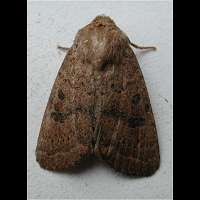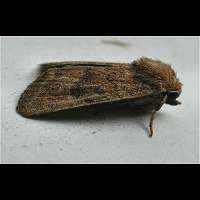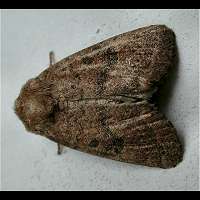Hoplodrina octogenaria
Hoplodrina octogenaria is a non-British species and the Brits may be content about that fact. This is one of the most awful Rustics to identify. Especially the Rustic is extremely similar. Hoplodrina octogenaria's ground colour is brownish or ochreous in males and ochreous to greyish brown in females. Females glisten, males don't. Most characteristic usually is the dark band running down from the kidney mark to the wing's lower edge. Other species, including the Rustic, do not have that band. Alas, quite a few darker females don't have it either in which case only examination under a microscope can solve the puzzle. On the continent you need some expert help when just beginning to name the various Rustics and allies. Hoplodrina octogenaria reaches a wingspan of some 29 to 37mm.
Hoplodrina octogenaria is depositing her eggs in summer. The larvae only feed by night and are well hidden in the foodplants during the day, often very close to the ground. They don't grow very fast. So, they pupate while still being caterpillar and continue their development in March and April of next year. Pupation takes place underground in a very firm cocoon. Quite a number of foodplants are known, all low growing plants, such as docks, stitchworts and primroses. The caterpillar is reddish brown. There is a faint light dorsal line. More striking is a dark zig zzag line connecting the spiraculae. The caterpillar is much lighter in colour below this line. There are warts on the body each producing one stiff little hair. Compared to the other Noctuid Caterpillars these hairs are long. Even compared to the hairs of some other Rustic caterpillars they are long. The shape of the caterpillar is quite plump, like most other Noctuid caterpillar's. The larvae grow to a length of 27 to 31mm.
Hoplodrina octogenaria is on the wing from the end of May to mid-August. This species flies by night only, but is attracted to light, sugar and flowering plants in the garden, such as Buddleia. Once caught it can be photographed easily the next day. If manipulated it may react strongly. A very common species on the continent, often appearing in great numbers. Not seen in Britain though.
Hoplodrina octogenaria is a non-British species and the Brits may be content about that fact. This is one of the most awful Rustics to identify. Especially the Rustic is extremely similar. Hoplodrina octogenaria's ground colour is brownish or ochreous in males and ochreous to greyish brown in females. Females glisten, males don't. Most characteristic usually is the dark band running down from the kidney mark to the wing's lower edge. Other species, including the Rustic, do not have that band. Alas, quite a few darker females don't have it either in which case only examination under a microscope can solve the puzzle. On the continent you need some expert help when just beginning to name the various Rustics and allies. Hoplodrina octogenaria reaches a wingspan of some 29 to 37mm.
Hoplodrina octogenaria is depositing her eggs in summer. The larvae only feed by night and are well hidden in the foodplants during the day, often very close to the ground. They don't grow very fast. So, they pupate while still being caterpillar and continue their development in March and April of next year. Pupation takes place underground in a very firm cocoon. Quite a number of foodplants are known, all low growing plants, such as docks, stitchworts and primroses. The caterpillar is reddish brown. There is a faint light dorsal line. More striking is a dark zig zzag line connecting the spiraculae. The caterpillar is much lighter in colour below this line. There are warts on the body each producing one stiff little hair. Compared to the other Noctuid Caterpillars these hairs are long. Even compared to the hairs of some other Rustic caterpillars they are long. The shape of the caterpillar is quite plump, like most other Noctuid caterpillar's. The larvae grow to a length of 27 to 31mm.
Hoplodrina octogenaria is on the wing from the end of May to mid-August. This species flies by night only, but is attracted to light, sugar and flowering plants in the garden, such as Buddleia. Once caught it can be photographed easily the next day. If manipulated it may react strongly. A very common species on the continent, often appearing in great numbers. Not seen in Britain though.






